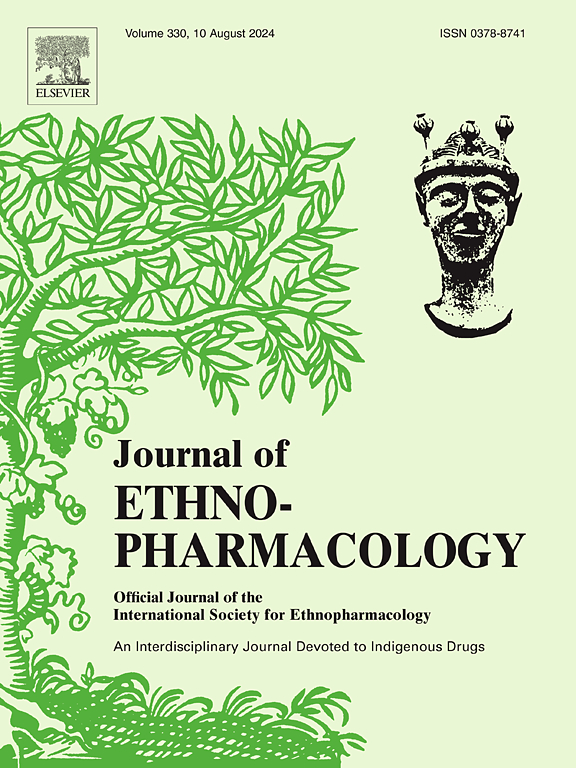补阳还五汤延缓心脏衰老的潜在分子机制:基于网络药理学、生物信息学和体内/体外实验验证。
IF 5.4
2区 医学
Q1 CHEMISTRY, MEDICINAL
引用次数: 0
摘要
民族药理学相关性:心脏老化与各种心血管疾病(CVD)的发生和发展密切相关。补阳还五汤(BYHWD)是一种经典的中药方剂,在临床上广泛用于治疗脑血管疾病和心血管疾病。然而,其在延缓心脏衰老中的作用及其潜在的分子机制尚不清楚。研究目的:本研究旨在探讨BYHWD在心脏衰老中的作用,并探讨其可能的分子机制。材料与方法:采用d -半乳糖(D-gal)建立体内和体外衰老模型,并给予BYHWD干预。组织病理学检查和生化分析评估心脏组织损伤,Western blot检测衰老相关标志物。非靶向代谢组学和网络药理学确定了潜在的靶点和途径。最后,采用RT-qPCR、免疫组化、Western blot等分子生物学方法验证关键通路中基因和蛋白的表达水平。结果:BYHWD有效减轻心脏病理损伤,显著抑制心脏组织中促炎因子Il-1β、Il-6、Tnf-α mRNA水平,下调衰老相关蛋白p16、p21、p53的表达。非靶向代谢组学分析显示,BYHWD可能通过调节能量和氨基酸代谢途径恢复衰老大鼠心脏代谢紊乱。网络药理学分析表明,BYHWD可能通过调节免疫和炎症反应延缓心脏衰老,其作用机制明显富集CaM/CaMKII/MAPK通路。RT-qPCR、免疫组化、Western blot进一步证实了BYHWD通过抑制CaM/CaMKII/MAPK通路对心脏发挥抗衰老作用。结论:BYHWD可有效延缓d -gal诱导的大鼠心脏和心肌细胞衰老。BYHWD通过调节能量和氨基酸代谢途径,抑制CaM/CaMKII/MAPK轴发挥抗炎作用。总的来说,这项研究为BYHWD延缓心脏衰老的机制提供了新的见解。本文章由计算机程序翻译,如有差异,请以英文原文为准。

Elucidation of the potential molecular mechanisms of Buyang Huanwu Decoction in delaying cardiac aging: Based on network pharmacology, bioinformatics, and in vivo/in vitro experimental validation
Ethnopharmacological relevance
Cardiac aging is closely associated with the occurrence and progression of various cardiovascular diseases (CVD). Buyang Huanwu Decoction (BYHWD), a classical traditional Chinese medicine formula, is widely used clinically for cerebrovascular and cardiovascular diseases. However, its role in delaying cardiac aging and the underlying molecular mechanisms remain unclear.
Aim of the study
This study aimed to investigate the role of BYHWD in cardiac aging and explore its potential molecular mechanisms.
Materials and methods
D-galactose (D-gal) was used to establish in vivo and in vitro aging models, with BYHWD administered as an intervention. Histopathological examination and biochemical assays assessed cardiac tissue damage, and Western blot detected aging-related markers. Untargeted metabolomics and network pharmacology identified potential targets and pathways. Finally, molecular biology methods such as RT-qPCR, Immunohistochemistry, and Western blot were used to validate the expression levels of genes and proteins in key pathways.
Results
BYHWD effectively alleviated cardiac pathological injury, significantly inhibited the mRNA levels of pro-inflammatory factors Il-1β, Il-6, and Tnf-α in cardiac tissues, and downregulated the expression of senescence-related proteins p16, p21, and p53. Untargeted metabolomics analysis revealed that BYHWD might restore metabolic disorders in the hearts of aging rats by regulating energy and amino acid metabolism pathways. Network pharmacology analysis demonstrated that BYHWD might delay cardiac aging by modulating immune and inflammatory responses, with the CaM/CaMKII/MAPK pathway being significantly enriched in its mechanism of action. RT-qPCR, Immunohistochemistry, and Western blot further confirmed that BYHWD exerted its anti-aging effects on the heart by inhibiting the CaM/CaMKII/MAPK pathway.
Conclusion
BYHWD was found to effectively delay D-gal-induced aging in both rat hearts and cardiomyocytes. Mechanistically, BYHWD modulated energy and amino acid metabolic pathways while inhibiting the CaM/CaMKII/MAPK axis to exert anti-inflammatory effects. Overall, this study provides novel insights into the mechanisms through which BYHWD delays cardiac aging.
求助全文
通过发布文献求助,成功后即可免费获取论文全文。
去求助
来源期刊

Journal of ethnopharmacology
医学-全科医学与补充医学
CiteScore
10.30
自引率
5.60%
发文量
967
审稿时长
77 days
期刊介绍:
The Journal of Ethnopharmacology is dedicated to the exchange of information and understandings about people''s use of plants, fungi, animals, microorganisms and minerals and their biological and pharmacological effects based on the principles established through international conventions. Early people confronted with illness and disease, discovered a wealth of useful therapeutic agents in the plant and animal kingdoms. The empirical knowledge of these medicinal substances and their toxic potential was passed on by oral tradition and sometimes recorded in herbals and other texts on materia medica. Many valuable drugs of today (e.g., atropine, ephedrine, tubocurarine, digoxin, reserpine) came into use through the study of indigenous remedies. Chemists continue to use plant-derived drugs (e.g., morphine, taxol, physostigmine, quinidine, emetine) as prototypes in their attempts to develop more effective and less toxic medicinals.
 求助内容:
求助内容: 应助结果提醒方式:
应助结果提醒方式:


